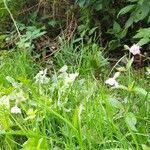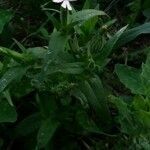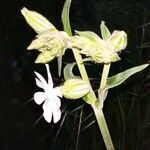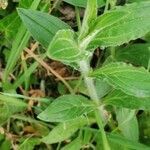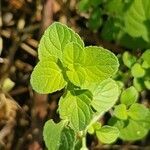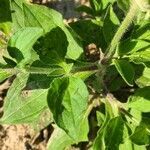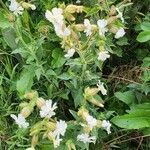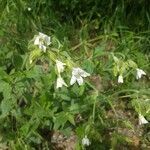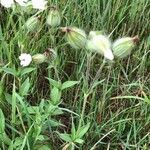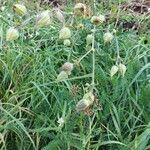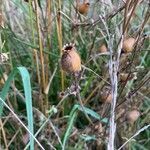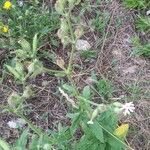Herbs annual, 30--50(--90) cm tall, densely shortly pubescent. Primary root slightly lignified. Stems erect, simple or sparsely branched, apically glandular hairy. Basal leaves long elliptic-obovate, 5--11 × 2--4 cm, both surfaces villous, midvein and lateral veins prominent, base attenuate into short petiole, half clasping, apex acute; distal leaves subsessile, narrowly elliptic or lanceolate. Dichasial cymes few flowered, glandular hairy; flowers bisexual, ca. 1.5 cm in diam. Pedicel erect, shorter than calyx; bracts lanceolate, glandular hairy. Calyx tubular, 2--2.5(--3) cm × ca. 5 mm, glandular hairy, inflated and ellipsoid at late anthesis, slightly constricted at apex; longitudinal veins 10, violet, reticulate; calyx teeth narrowly lanceolate, 8--10 mm. Androgynophore ca. 2 mm. Petals ca. 2.5 cm; claws slightly exserted beyond calyx, narrowly oblanceolate, glabrous, auricles triangular; limbs pale pink, yellowish below, obovate, ca. 6 mm, deeply bifid to 1/2 to 2/3 of limbs; lobes entire or slightly erose, inrolled at daylight; coronal scales ovoid, small, 2--4-toothed. Stamens included; filaments glabrous. Styles 3, slightly exserted. Capsule ovoid, 1.5--1.8 cm, shorter than calyx. Seeds dark brown, reniform, ca. 1 mm. Fl. Jun--Jul, fr. Jul--Aug. 2n = 24.
Herb, annual, usually densely and softly hairy, ± glandular above. Stems erect, usually unbranched, 25–75 cm high. Leaves oblanceolate to elliptic or narrowly lanceolate, 10–100 mm long, 3–40 mm wide, with white, spreading hairs, glandular below; lower leaves smaller than cauline leaves, usually withered at flowering, with petioles to 25 mm long; upper leaves sessile. Inflorescence lax, few-flowered; bracts herbaceous. Pedicels 3–20 mm long, densely glandular hairy. Flowers unisexual, 8–12 mm diam. Calyx with flexuose hairs; male calyx 20–25 mm long, 10-veined; female calyx 20–30 mm long, 10-veined, inflated in fruit; calyx lobes linear to narrowly triangular, acute. Petal limb 4–12 mm long, inrolled during day, creamy white or sometimes pinkish above, yellowish below, bifid. Styles 3. Capsule ovoid-conical, 11–18 mm long, with 6 recurved teeth; carpophore 1–3 mm long, glabrous. Seeds ±reniform, 0.8–1.0 mm diam., dark brown to black, bluntly tuberculate; dorsal edge flat to ± grooved, but not winged..
Taprooted annual. Stems erect, usually unbranched, stout, with short glandular and long eglandular hairs, 20-35 cm tall. Lvs densely hispid, green; basal lvs oblanceolate-spathulate, acute, 5-8 × 1-3 cm; stem lvs becoming linear-lanceolate, very shortly connate, acute, 3-8 × 0.5-2 cm. Infl. a 3-10-flowered dichasium; pedicels 1-3 cm long; bracts linear-subulate, green. Fls ☿. Calyx with short glandular and short and long eglandular hairs, cylindric at flowering, ovoid at fruiting, contracted at mouth, 18-23 mm long, 10-veined; teeth linear-acuminate, erecto-patent. Petals pink above, yellowish beneath, inrolled by day, spreading at night, deeply divided; claw not lobed; coronal scales oblong, obtuse, c. 2 mm long. Styles 3, erect, c. 5 mm long. Capsule ovoid, slightly exserted, 10-14 mm long; teeth 6; carpophore c. 2 mm long. Seeds dull brown, reniform, papillate, c. 1.3 mm long.
Annual, 2–8 dm, densely and coarsely hirsute below, viscid with abundant glandular hairs above; lvs lance-ovate to elliptic-oblanceolate, 5–12 × 2–4 cm, the basal petiolate, the cauline narrower, sessile, infl loosely branched; fls mostly perfect; cal 1.5 cm at anthesis, inflated and 2.5–3 cm in fr, the 10 nerves glandular and freely anastomosing, the lance-linear lobes 5–9 mm; pet blade 7–10 mm long, deeply 2-lobed, pink above, yellowish beneath, inrolled during the day, opening in the evening; auricles 1–1.5 mm, the broad appendages 0.5–1.5 mm, entire or erose; carpophore 1–3 mm; styles 3; fr 3-locular, opening by 6 teeth; seeds 0.8–1 mm, rugose-papillate; 2n=24. Native of Europe, widely distributed as a weed in most of the U.S. and s. Can. July–Sept.
Coarse annual. Stems up to 50 cm, erect, robust, usually unbranched; densely hairy in lower part, viscid in upper. Leaves ovate to ovate-narrowly elliptic, 2.5-5 by 0.5-1.5 cm. Inflorescence few-flowered; pedicels usually short, rarely up to 2 cm. Flowers large, bisexual, scented in the evening. Calyx 2-2.5 cm, 10-nerved, teeth long, slender, 5-7 mm. Petals pink above, yellowish below, inrolled in daytime, opening in the evening, lamina 8-12 mm. Capsule ovoid-conical, 15-18 by 8-10 mm, shorter than calyx without teeth. Seeds dark brown to reddish brown, flattened orbicular, rugose, 0.8-1.1 mm.
